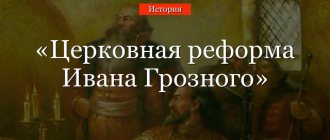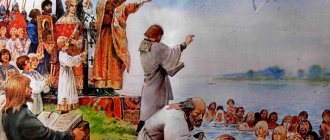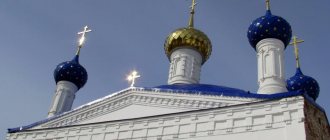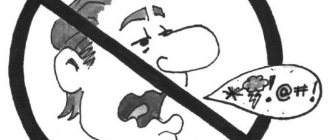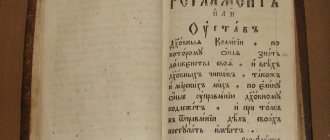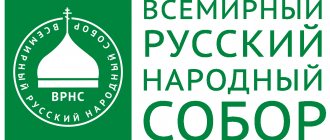Historical background
By 1701, the Russian emperor was very dissatisfied with the negative attitude of the clergy towards the transformations carried out in state and public life. Church ministers believed that all innovations destroyed the old system and customs to which they were committed. The religious policy of the clergy prevented Peter 1 from creating an absolutist state modeled on the countries of Western Europe.
Even in his youth, the emperor wanted Patriarch Adrian to put the spiritual order in order, but the church leader was against any changes in the state structure of Russia. By the beginning of the 18th century, the prerequisites for the adoption of reforms against the patriarchate had developed:
- Most monks considered the emperor the Antichrist and were against his reforms.
- Excessive authority of the church, which was expressed in a strong influence on ordinary people.
- Monasteries and churches owned large financial and human resources that were not accountable to the state.
Every year, Peter's dissatisfaction with religious politics only intensified, so he often attributed his mistakes and failures to the resistance of the clergy. In short, the church reforms of Peter 1 were aimed at preventing confrontation between clergy, namely:
- Elimination of the opportunity for the Moscow Patriarch to grow into a second sovereign, equivalent to an emperor.
- Submission of the clergy to state laws and the king.
- Elimination of economic and administrative self-government through a detailed audit of property, appointment of positions by the state apparatus, strict regulation of the duties of the clergy and financial transactions.
- Reducing the number of churchmen and monks in the patriarchate, introducing a ban on the construction of monasteries.
- The fight against spontaneous beggary, since the emperor believed that only the blessed and the disabled could live on alms.
Peter 1 prepared very carefully for the reorganization of church government, holding frequent meetings with the Eastern patriarchs. Their essence was to resolve spiritual and political issues.
The reason the emperor turned specifically to the eastern clergy was that they were supported by the Russian government, and Patriarch Dositheus informed about everything that was happening in Constantinople.
Position of the Church before the reforms of Peter I
At the end of the 17th century. The church was in some kind of crisis, which was due to its position in society, the virtual absence of a system of religious education and training, as well as the church schism that continued from the 1650s. In general, the church was in a privileged position, owning enough land and not paying taxes. The independent and influential policy of the patriarch threatened the power of the tsar, so Alexei Mikhailovich understood the need for reforms, but he never decided to take active action, although he somewhat limited the rights of the church: the transfer of land to the church was stopped, etc.
Finished works on a similar topic
- Course work: Church reform of Peter I 420 rub.
- Abstract Church reform of Peter I 220 rub.
- Test work Church reform of Peter I 190 rub.
Receive completed work or specialist advice on your educational project Find out the cost
Peter I, due to his energetic policy, switches to radical measures. Basically, he was interested in increasing financial resources for waging the Northern War with Sweden and carrying out further reforms. A sufficient amount of finance could be obtained from the church.
Peter strove for a state that would be based on Western European customs, and this did not imply a significant role for the church. In addition, the majority of the clergy opposed Peter's reforms, which further aggravated the situation. Over time, dissatisfaction with the clergy intensified: Peter even began to attribute the bulk of his problems during the reforms to the secret resistance of the clergy.
In 1707, Metropolitan Isaiah of Nizhny Novgorod was deprived of his chair for protesting against the actions of the Monastic Order in his diocese and sent to the Kirillo-Belozersky Monastery
A blow to the clergy was the case of Peter’s son, Alexei, with whose name many churchmen pinned hopes for the restoration of the previous order. Alexei maintained contact with Metropolitan Ignatius of Krutitsa, Metropolitan Joasaph of Kyiv, and Bishop Dosifei of Rostov. However, after Alexei's arrest and investigation, some churchmen were executed or exiled.
Have questions about this topic? Ask a question to the teacher and get an answer in 15 minutes! Ask a Question
Carrying out reform
After the death of Patriarch Adrian, the emperor began in every possible way to prevent the election of a new head of the clergy. At the same time, the Monastic Order was created, to which the lands of the monasteries and bishop's property were transferred. It was led by a secular person, that is, virtually all control and judicial proceedings over the clergy were exercised by the state.
Peter 1 was most interested in church wealth, so the first transformations were more of a material interest than a spiritual one. Several decrees were issued that limited the activities of the clergy:
- all dissenters were expelled from the monasteries;
- It was allowed to become a nun only after 40 years of age;
- monks were prohibited from owning land;
- It was forbidden to give alms, and voluntary contributions could only be made in almshouses.
The tsar's decision on the future fate of the church structure was hindered by the Northern War, and after victory in it, the emperor returned to reform. To resolve some of the nuances, he enlisted the help of the Bishop of Narva and Pskov, who was entrusted with developing regulations for interaction between the state and the church.
According to this document, the tsar issued a decree on the abolition of the patriarchate and the formation of the highest body of the clergy - the Synod. Scheme of the church hierarchy under Peter 1:
- Emperor.
- Synod.
- Metropolitans and bishops.
- Priests.
- Deacons.
The Synod, which depended on Peter 1, was a collegial structure consisting of bishops. As a result, the creation of a new body led to the abolition of the existence of councils and the patriarchate for almost 200 years. In 1722, the emperor approved the position of chief prosecutor, who was obliged to monitor the activities of the Synod.
Thus, church life was completely subordinated to the state. At the same time, Peter 1 issued a decree restricting entry into the clergy. Special schools were opened to train future clergy. The number of monasteries throughout the country was significantly reduced, and in addition, their activities were reorganized.
During the church reform, the position of traditional faiths (Muslim, Catholicism) began to spread widely in Russia, but Orthodoxy was considered the leading one. Therefore, Muslims who owned land did not have the right to own Orthodox peasants.
Test on the topic: The Church under Peter I
Time limit: 0
Navigation (job numbers only)
0 of 4 tasks completed
Questions:
- 1
- 2
- 3
- 4
Information
Check yourself! Historical test on the topic: The Church under Peter I
You have already taken the test before. You can't start it again.
The test is loading...
You must log in or register in order to begin the test.
You must complete the following tests to start this one:
results
Correct answers: 0 out of 4
Your time:
Time is over
You scored 0 out of 0 points (0)
Categories
- No category 0%
- 1
- 2
- 3
- 4
- With answer
- With a viewing mark
- Task 1 of 4
1.
In what year was the patriarchate abolished in Russia?
Right
Wrong
- Task 2 of 4
2.
For what period was the patriarchate suspended in Russia?
Right
Wrong
- Task 3 of 4
3.
In what year was the Holy Synod established?
Right
Wrong
- Task 4 of 4
Positive aspects of the reform
- The state began to receive money from the clergy : church lands were sold to everyone, income received from monasteries and churches began to be taxed. There was a ban on the construction of monasteries. Also, financial affairs improved due to the fact that the number of clergy was reformed. The monks were subjected to a special reduction; they were ordered to secure themselves in those places where they would be counted by a special scribe. All those not tonsured were required to leave the monastic lands.
- The size of the army increased due to the fact that recruitment extended to people in the church, with the exception of clergy and their families.
- The fight against beggary began ; only truly infirm people were allowed to enter almshouses.
- Thanks to the reform, the centralization of the state was completed , due to the fact that the church lost its power, and the king became the only ruler.
- For some time in Rus' there were positive actions towards other faiths. Marriages of Orthodox Christians with people of a foreign religion were allowed.
- The number of clergy decreased, resulting in a more efficient distribution of human resources . One monk was assigned to care for the poor for 3-4 people. 2 clergy were needed for a parish of 250 households. If a clergyman was considered superfluous, then he had to find a new place for himself.
- Church reform includes the transformation of the calendar ; now the date of the New Year has been moved to January 1.
- A new alphabet came out of the printing house , which “lost” several letters from the one created by Cyril and Methodius. The vocabulary has been enriched by borrowing from foreign languages.
- Feofan Prokopovich, Peter’s assistant in creating the reform, published an primer with an interpretation of the “Our Father” and the commandments from the Gospel. Later this book was read at sermons.
- The number of “vagrant clergy” was reduced ; such priests stood at the crossroads of large streets where people gathered. There they offered their services: to celebrate the service at home or read the magpie. This situation was possible due to the ease of obtaining ordination, so Peter took measures to reduce the number of clergy. He had a positive attitude towards those who wanted to leave the rank. The tsar also forbade clergy to visit homes; they were only allowed to visit the sick and dying.
Functions of the Synod
Synod
(from the Greek “assembly”, “cathedral”) became the highest state body of church-administrative power, replacing in some respects the patriarch and councils of bishops of the local church.
The patriarchal orders (ecclesiastical, state and palace), the order of church affairs and the office of schismatic affairs, as well as the printing office, were transferred under the control of the Synod. Officially, the Synod was given equal rights with the Senate. The main goal pursued by Peter 1 during its establishment was the same as when establishing the Collegiums - streamlining and division of administrative functions. In addition, Peter wanted to reduce, if not completely eliminate, the independence of the Church and its isolation in state affairs. He decided to use it more profitably for the benefit of the country.
Internal structure of the Synod
The Synod consisted of 12 people. As in other Collegiums, here the president presided, who was replaced, if necessary, by two vice-presidents; Advisors, assessors, and the office were also present. All members of the Synod, before taking office, took an oath and oath before the Gospel. Control over the activities of this body, as in the case of civil colleges, was carried out by the prosecutor.
The first president of the Synod was Metropolitan Stefan, who subsequently had absolutely no influence on decisions made, in contrast to Bishop Theodosius, devoted to the tsar, who was appointed vice-president.
